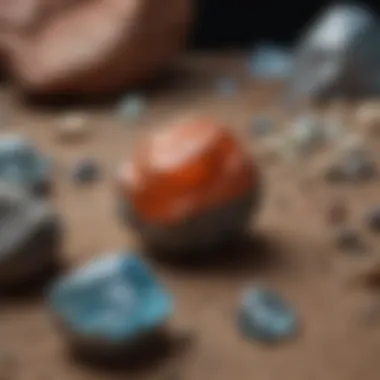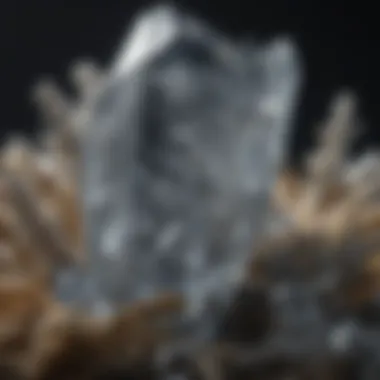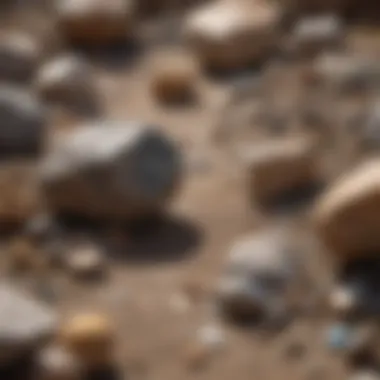Identifying Minerals Through Photos: A Comprehensive Guide


Intro
The field of mineral identification has evolved significantly with advances in technology. In this comprehensive guide, we will delve into the innovative practice of identifying minerals through photographs. This method not only streamlines the process but also enhances precision when identifying rock and fossil specimens. By understanding the underlying methodology, tools used, and relevant technologies, readers will gain insights into the advantages and challenges faced in this discipline. This guide aims to cater specifically to rock and fossil collectors, educators, and geology enthusiasts.
Rock and Fossil Identification
Mineral identification through photographs begins with a solid understanding of rocks and fossils. The intricate structures and varied characteristics of these specimens can be captured effectively in images, providing essential details for accurate identification.
Types of Rocks and Fossils
Rocks can generally be classified into three main categories: igneous, sedimentary, and metamorphic. In contrast, fossils showcase biological remnants from ancient organisms and come in various forms, including molds, casts, and amber-preserved specimens.
Characteristics to Look For
When examining minerals, key characteristics include:
- Color: The surface hue can provide initial clues but can be misleading.
- Luster: This refers to how light interacts with the surface, categorized as metallic, glassy, or dull.
- Hardness: The Mohs scale is a common reference point, helping to determine a mineral's resistance to scratching.
- Streak: The color of a mineral's powder can differ from its surface color, offering further identification clues.
- Crystal form: The arrangement and shape of crystals can aid in classification.
Tools for Identification
Utilizing the right tools is essential for precise mineral identification.
- Camera: A high-resolution camera is crucial for capturing detailed images.
- Lighting: Natural light in combination with artificial sources enhances clarity and color accuracy.
- Software: Image analysis programs like ImageJ or specific mineral identification apps can aid in detailed examination and comparison.
Collecting Tips and Techniques
The quest to collect rocks and fossils requires thoughtful techniques for both success and sustainability.
Best Practices for Collecting
- Research: Start by gathering information about geology in your area.
- Equipment: Always carry essential tools, such as geological hammers, chisels, and safety goggles.
- Respect Regulations: Understand laws related to collecting in protected areas, observing all local regulations.
Locating Prime Collecting Sites
Certain regions are known for their richness in fossils or unique rocks. Look into:
- National parks
- Geological formations unique to your locality
- Historical dig sites
How to Safely Extract Specimens
To minimize damage to the specimen and the surrounding environment, avoid overshooting your tools, and always use gentle pressure during extraction. Respect the integrity of the area you are working in and aim for sustainability in your collecting efforts.
Preservation and Display
Once you have acquired your specimens, the next step is preservation and display.
Techniques for Preserving Rocks and Fossils
Proper preservation methods can significantly prolong the life of your specimens:
- Use conservation-grade materials for storage.
- If necessary, apply consolidants that do not alter the specimen's appearances.
Proper Storage Methods
- Controlled Environment: Store in a cool, dry place, as humidity can lead to decay.
- Containers: Use acid-free boxes or display cases to protect your finds from damage.
Creative Display Ideas


You might consider creating a themed collection. Arrange them according to type, location, or even geological time period. Utilize soft lighting to enhance their appearance while on display.
Geological Insights
Having an understanding of the broader geological context enhances the significance of mineral identification.
Geological Formations and Processes
Minerals form through various geological processes, including sedimentation, crystallization, and metamorphism. Understanding these processes can inform collectors about where to seek their next specimen.
Historical Significance of Rocks and Fossils
Many specimens carry rich histories, displaying evidence of life from millions of years ago. Learning about notable discoveries can stimulate a deeper interest in geology.
Notable Discoveries in the Field
The field has seen remarkable discoveries that indicate the complexity of Earth's history. For instance, the Chengjiang biota, known for its well-preserved fossils, gives insight into early life forms.
Studying minerals and fossils through photography equips collectors with valuable metrics for identification and enhances their understanding of geological history.
This guide serves as a stepping stone for anyone interested in mineral identification, ensuring a well-rounded understanding of the subject. With the integration of technology and photography, the world of geology becomes increasingly accessible.
Preamble to Mineral Identification
In the realm of geology, mineral identification is a fundamental skill. It allows enthusiasts, educators, and collectors to understand the materials they encounter. While traditional methods often involve tactile examination and chemical testing, the advent of photography presents an innovative approach. Identifying minerals through photographs has become increasingly relevant due to its accessibility and efficiency. This article delves into the nuances of mineral identification via images, exploring various techniques and considerations.
Understanding the Basics
Mineral identification starts with recognizing the properties that differentiate one mineral from another. Basic characteristics include color, luster, hardness, and crystal form. Visual assessment plays a critical role in this identification process. A good photograph can preserve these properties for later analysis. Thus, capturing a clear image is essential.
High-resolution images allow observers to detect subtle details that might be missed by the naked eye. This can include inclusions, growth patterns, or surface textures. With the right equipment and techniques, anyone can enhance their identification skills without needing extensive laboratory resources.
The Importance of Accurate Identification
Accurate mineral identification has far-reaching implications. Firstly, it provides context within geological formations. Minerals represent history; each one tells a story about the conditions in which it formed. For collectors, knowing the precise identity of a specimen can increase its value and significance.
Moreover, accurate identification is crucial for educational purposes. By understanding minerals more deeply, students and enthusiasts can appreciate the diversity of Earth’s resources. This knowledge fosters a more profound respect for geology and can even inspire conservation efforts. In a world where misidentification can lead to misconceptions or lost opportunities, precision in identification cannot be understated.
The Role of Photographs in Mineral Identification
Photographs serve a foundational role in the identification of minerals, emerging as a critical tool for both amateur and experienced collectors. The advent of photography in mineralogy has greatly enhanced our ability to document and analyze specimens. By capturing detailed images, one can convey various attributes that are vital for proper identification. This section will explore the significance of photographs, the unique qualities of minerals observable through images, and the techniques that optimize clarity in mineral photographs.
Visual Characteristics of Minerals
Visual characteristics are the first points of distinction when identifying minerals. These include color, luster, transparency, and texture. Each of these attributes plays a pivotal role in determining the mineral type. For instance, the specific hues can indicate the presence of certain elements within the mineral's structure, while the luster can range from metallic to dull, providing insights into its composition.
A high-quality photograph can capture these details, allowing for better comparisons with reference materials. This shared visual language facilitates a deeper understanding among collectors and researchers.
Photographic Techniques for Clarity
To ensure that photographs serve their purpose in mineral identification, several techniques come into play.
Lighting Considerations
Lighting is arguably the most significant factor contributing to clarity in photos. Proper lighting can reveal textures and colors that may otherwise remain hidden. Natural light typically provided an authentic representation of a mineral's appearance, but it can be inconsistent.
LED lights are commonly used for their versatility and steadiness. A good lighting setup may reduce shadows and reflections, creating a more even illumination of the mineral surface. However, care should be taken to avoid overexposing certain features, which might lead to loss of detail.
Background Selection


The background selected for photographing minerals profoundly impacts the perception of visual characteristics. A neutral background, such as white or gray, can help highlight the mineral by eliminating distractions. This approach is beneficial for showcasing unique colors and textures.
However, contrast is key; a background that is too light or dark could obscure important features. Thus, choosing a background that complements the specimen while allowing its natural attributes to stand out is crucial.
Focus and Detail
Achieving the right focus is essential for capturing the intricacies of a mineral's surface. A macro lens is often used to render fine details clearer, making it easier for the observer to note specific formations or imperfections.
Maintaining sharpness throughout the image is vital. If parts of the image appear blurry, it may mislead viewers about the mineral's characteristics. Proper focus ensures that all significant features are documented and allows for better analysis during identification.
Technological Advancements in Photo Identification
The landscape of mineral identification has experienced significant transformation with technological advancements. These developments are essential for improving accuracy and accessibility in mineral identification through photography. Modern tools and approaches leverage sophisticated algorithms and mobile technology, which enhance the capabilities of enthusiasts and professionals alike. This section explores the software tools and mobile applications that have emerged, revealing their contributions to mineral identification.
Software Tools for Analysis
Image Recognition Software
Image recognition software stands as a crucial element in the process of mineral identification through photos. Its ability to analyze visual data and match it with a database of mineral images presents a noteworthy advantage. This type of software often utilizes complex algorithms, enabling it to recognize patterns and features specific to various minerals.
One key characteristic of image recognition software is its speed. For enthusiasts and researchers, obtaining quick results can be indispensable. However, dependency on high-quality images is essential, as the software’s accuracy relies heavily on image clarity.
A unique feature of many image recognition programs is their adaptability. Software like Google Lens allows integration with mobile devices, enabling users to identify minerals on-the-go. Nevertheless, limitations do exist. For instance, the accuracy might regress with less-known or rare minerals, and users may have to validate results through traditional methods or community feedback.
Machine Learning Applications
Machine learning applications represent the next frontier in mineral identification, combining vast datasets with self-learning capabilities. This technology allows the software to continuously improve its identification performance as it ingests more information. One of the essential aspects of machine learning applications is the potential to identify trends and subtle distinctions among similar minerals that might be overlooked by conventional methods.
These applications are favorable because they can exploit extensive databases, yielding results with high accuracy rates. The unique feature of machine learning is its capacity to learn from past errors and successes, refining its analytical skills over time. Even so, the system often requires a substantial amount of training data and human supervision for optimal performance.
Mobile Applications for Enthusiasts
Mobile applications have democratized the process of mineral identification. They allow anyone with a smartphone to embark on mineral exploration and identify specimens with remarkable ease. Some notable apps, like Rock & Mineral Finder and Gem Hunter, offer user-friendly interfaces and step-by-step guides for identifying common minerals using photographs.
These tools furnish users with the ability to manage and share their findings, often linking them to micro-communities of enthusiasts. However, the effectiveness of these applications often hinges on the quality of the input photos and the range of minerals the database encompasses. Engaging with these tools can bolster one’s confidence in identification efforts, yet it is wise to consider them as supplements to comprehensive knowledge rather than replacements.
Challenges in Mineral Photo Identification
Identifying minerals through photographs presents unique challenges that can influence the effectiveness and accuracy of the process. Understanding these challenges is crucial for anyone engaged in the field of mineral identification, from hobbyists to seasoned professionals. With the ever-growing reliance on photographic analysis, the obstacles in this area merit closer examination.
Ambiguities in Visual Features
One major challenge in mineral photo identification arises from ambiguities in visual features. Minerals often exhibit a wide range of colors, lusters, and textures that can overlap significantly across different species. For instance, two distinct minerals might have similar colors but different crystalline structures, leading to misidentification if evaluated solely through images. The interpretations of these visual characteristics can hinge on several factors, including lighting conditions and camera settings, which can alter the appearance of a mineral.
Furthermore, minerals can appear differently when viewed from various angles or under different lighting conditions. This variability can create confusion during identification. Even the presence of impurities and surface weathering can complicate visual judgement. To mitigate these issues, employing techniques that ensure consistent photography practices is vital. It is essential to create a standardized approach, focusing on the detailed documentation of each mineral's features to reduce misinterpretation.
Limitations of Technology
Limitations of technology also pose significant hurdles in photographic mineral identification. While advancements in imaging techniques and machine learning have enhanced identification capabilities, they are not infallible. Many existing software tools rely heavily on well-defined image databases, which may not cover every possible mineral variety or the unique conditions under which they can be found. This can lead to missed identifications or erroneous results.
Moreover, mobile applications designed for on-the-go enthusiasts may lack the sophistication of professional software. They are useful for basic identification, but more complex analysis, such as spectral analysis, often requires specialized equipment and expertise. Additionally, varying smartphone camera qualities can result in inconsistent image resolution and detail, which directly impacts the reliability of the information derived from photographs. Therefore, while technology presents exciting opportunities, recognizing its limitations is essential for accurate mineral identification.
Comparative Analysis: Photo vs. Physical Identification
The process of identifying minerals can rely on multiple approaches. Among them, comparing photo identification to traditional physical examination proves necessary. Each method brings unique advantages and challenges. This section delves into their respective benefits and contexts wherein one might be favored over the other.
Benefits of Photo Identification


Photo identification of minerals provides various significant benefits. It allows enthusiasts to capture images from the comfort of their homes, accessing a wealth of resources online. Key advantages include:
- Accessibility: Using cameras or smartphones simplifies the process. Collectors can easily document specimens without needing expert assistance.
- Convenience: An ideal photo eliminates the need for physical handling or transport of potentially delicate specimens.
- Record Keeping: Photos create a visual database which can be crucial for tracking your collection over time.
- Community Learning: Online platforms allow for sharing images with other enthusiasts, promoting knowledge exchange and collective learning.
- Image Analysis Tools: Advances in software tools facilitate enhanced analysis that can elevate the accuracy of identification.
"Photo identification offers a gateway to discovering minerals without the steep travel and handling demands of physical identification."
Situations Favoring Physical Examination
Despite the many benefits of photo identification, there are scenarios where physical examination welcomes distinct advantages. Key situations include:
- Texture Analysis: Certain minerals are identified primarily by their physical characteristics like texture and feel, which are hard to perceive in photographs.
- Weight and Density: Physical specimens allow collectors to assess weight and density, factors crucial to identification.
- Environmental Context: Observing minerals in their natural habitats can provide clues about their formation and characteristics not evident in images.
- Chemical Testing: Some identification methods require hands-on tests, such as streak tests or acid tests, which necessitate physical specimens.
- Verification: Consulting experts often involves physical examination as nuanced details can sometimes be missed in photographs.
Understanding the distinct applications of both photo and physical identification can empower rock and fossil collectors to choose the most appropriate method for their needs.
Best Practices for Effective Mineral Photo Identification
Identifying minerals through photos relies heavily on the quality and clarity of the images. Following best practices can greatly improve the accuracy of the identification process. With the advancements in technology, it becomes vital to adapt to the best practices that enhance the overall effectiveness of mineral photo identification.
Creating a Reliable Photo Database
Establishing a reliable photo database is key to organized mineral identification. This creates a foundation for comparison and aids in recognizing patterns or specific features unique to certain minerals. A well-structured database allows for quick retrieval of photos. Use consistent labeling techniques, including mineral name, locality, and date of capture. This practice ensures that every entry is easy to track and reference later.
In addition, maintaining high-resolution images improves the ability to discern minute details that are often crucial for identification. For optimal results, utilize digital storage that allows for easy categorization and searching.
Engaging with Online Communities
Connecting with online communities is essential for those eager to enhance their mineral identification skills. Engaging with knowledgeable groups can yield valuable insights and foster collaboration.
Forums and Social Media Groups
Forums and social media groups provide a platform for enthusiasts and collectors to share knowledge and experience. These communities are often filled with individuals who possess diverse expertise in mineral identification. The key characteristic of these forums is the exchange of information. Members can post their photos and queries, receiving feedback from others who may recognize certain features. This collaborative approach is a beneficial choice for learning and expanding one's knowledge base.
However, it's important to consider the varying levels of expertise among members. While many provide accurate information, some may present misleading or incorrect advice. Thus, users must approach all input critically and verify facts through additional reliable sources.
Shared Resources and Collaboration
Shared resources and collaboration amplify the capabilities of individual collectors. Many online communities host databases, guides, and shared articles that add to collective knowledge. This sharing is particularly useful for beginners who may lack access to in-depth resources.
A unique feature of shared resources is that they often include contributions from experts in the geology field. Accessing verified information can enhance learning. However, the challenge remains in differentiating between high-quality content and lesser resources. To mitigate this, users should prioritize established platforms known for their reliability and accuracy, such as Wikipedia and Britannica.
The importance of engaging with communities cannot be overstated. It is through these connections that many enthusiasts find valuable guidance and support.
By practicing these best methods for photo identification and involving oneself in online environments, rock and fossil collectors can greatly enhance their proficiency. Engaging with a community not only broadens one’s outlook but also fosters a deeper appreciation for the complexities of mineral identification.
The End and Future Directions
In summarizing the insights gained from this exploration into mineral identification through photographs, it is essential to recognize the significance of these findings for both enthusiasts and professionals in geology. The combination of advanced imaging techniques, community engagement, and available software tools illustrates a transformative approach to mineral identification.
Accurate mineral identification is crucial for various applications, from educational purposes to collection management. By utilizing high-quality images and following best practices in photo documentation, rock and fossil collectors can significantly improve their identification efforts. Moreover, the incorporation of mobile apps and software tools adds an extra layer of convenience and efficiency to this process.
Summary of Key Insights
In summary, a few key insights emerge from our discussion:
- Importance of Image Quality: Clear, well-lit photographs greatly enhance the ability to identify minerals accurately.
- Technological Integration: The growth of image recognition and mobile applications offers valuable tools for both novices and experts.
- Community Contribution: Engaging with online communities fosters knowledge sharing, creating a richer resource base for mineral identification.
These elements collectively contribute to a more robust understanding of mineral characteristics, facilitating better identification practices.
The Future of Mineral Identification
Looking ahead, the future of mineral identification appears promising, driven by ongoing technological advancements. As machine learning and artificial intelligence evolve, their integration into mineral identification will likely refine accuracy even further. We can expect software that can analyze images more effectively and suggest possible mineral identifications based on vast databases, improving both the speed and reliability of identification processes.
Additionally, the continuing rise of online platforms will allow enthusiasts to connect, share their findings, and learn from each other. The merging of community input with technological prowess could cultivate a more informed and resourceful community of geology enthusiasts. The emphasis on learning and collaboration is likely to shape the landscape of mineral identification, paving the way for richer experiences in the field.
With these developments, we can envision a future where identifying minerals through photographs becomes even more intuitive and accessible for everyone, enhancing both knowledge and appreciation of the natural world.







